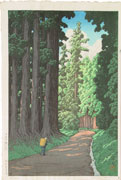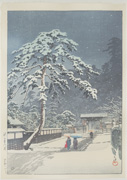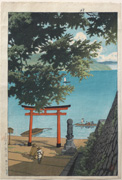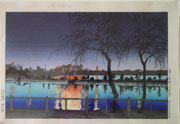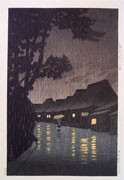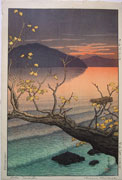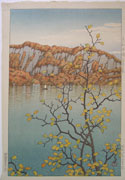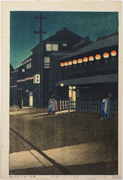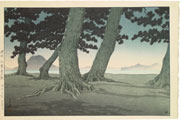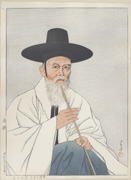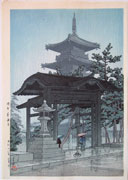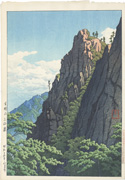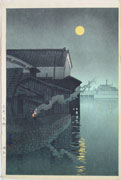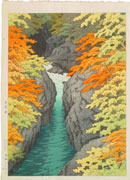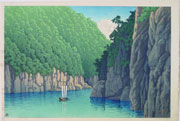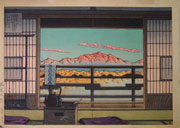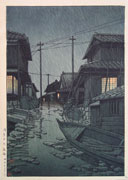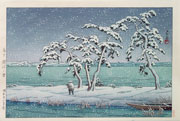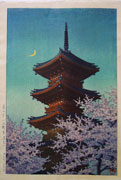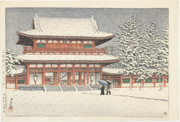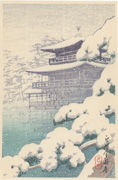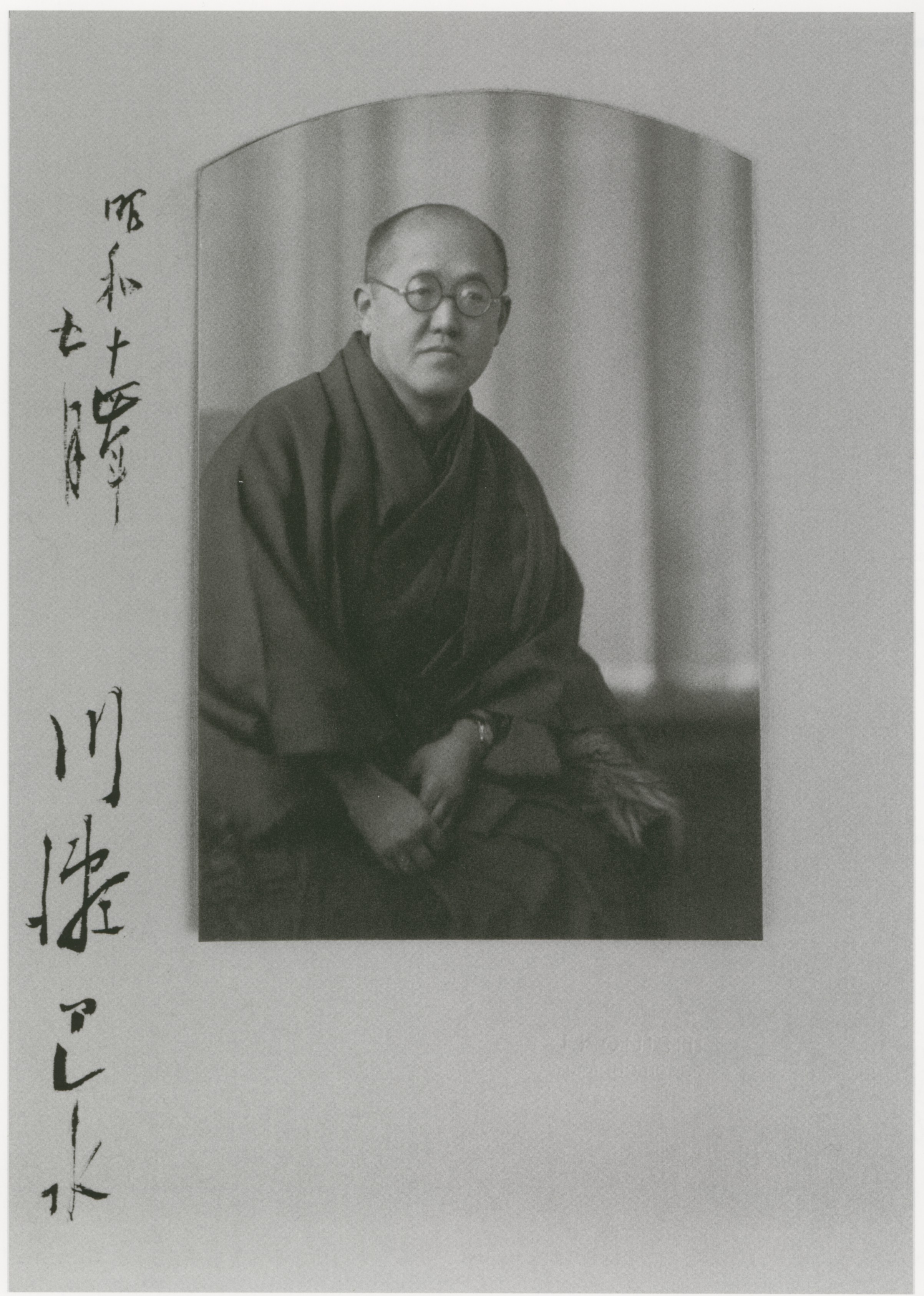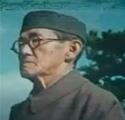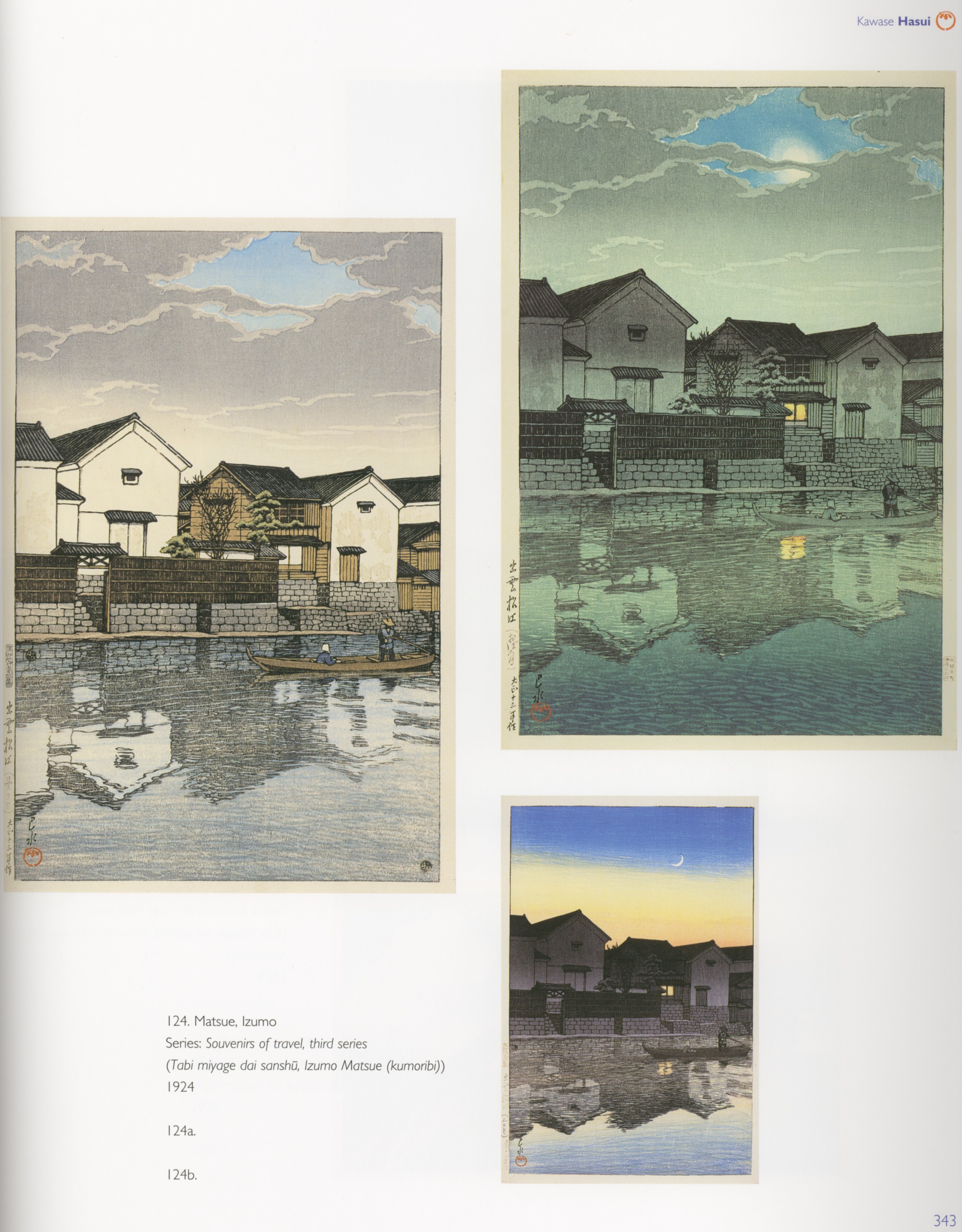Prints in Collection
The Nikko Highway, 1930 IHL Cat. #68 | Honmon Temple, Ikegami, 1931 IHL Cat. #2 | IHL Cat. #1027 |
Night at Shinobazu Pond,
1932
IHL Cat. #3
| Rain in Maekawa, Soshun, 1932 IHL Cat. #7 | Nenokuchi, Towada, 1933 IHL Cat. #67 | Senjo Cliff, Lake Towada, 1933 IHL Cat. #32 | Evening at Sōemon-chō, Osaka, 1933 IHL Cat. #558 |
| Teranohama,Sanuki Coast, 1934 IHL Cat. #21 | A Yangban, 1935 IHL Cat. #31 | Zensetsū temple, Sanshū, 1937 IHL Cat. #289 |
Samburam Rock, Kumgang Mountain, 1939 IHL Cat. #72 | Daimotsu, Amagasaki, 1940 IHL Cat. #293 |
| Toro, Kishū, 1943 IHL Cat. #70 | Morning at the Arayu Spa, Shiobara, 1946 IHL Cat. #22 | Evening Rain in Kawarago, 1947 IHL Cat. #4 |
Snow at Hi Marsh, Mito, 1947 IHL Cat. #1 | Spring Dusk at the Tosho Shrine, Ueno, 1948 IHL Cat. #71 | Snow at Heian Shrine, Kyoto, 1948 IHL Cat. #30 |
Small Format Prints
Kyoto Kinkakuji, 1930-1936 IHL Cat. #1538 | -intentionally left blank- | -intentionally left blank- |
Biographical Data
(from Kawase Hasui: The Complete Woodblock Prints, Hotei Publishing, 2003) | ProfileKawase Hasui (1883-1957)Source: Carnegie Museum of Art website http://www.cmoa.org/exhibitions/archives04fall.asp#kawase Kawase Hasui is considered one of the most important Japanese landscape artists of the 20th century. His prints, produced under the guidance and stern eye of his publisher, Watanabe Shōzaburō (1885-1962), are the modern continuation of the unforgettable works by Hiroshige and Hokusai, the 19th-century masters of this genre. As none other, he could evoke Japan of the eventful interwar period. Hasui's work enjoyed huge popularity from his very first print of 1918. In contrast to his illustrious 19th-century predecessors, his work was immediately successful in the rest of the world. His publisher, Watanabe Shōzaburō, recognized the enormous potential of the American market, which resulted in Hasui's prints fetching high prices at auctions in New York as early as the 1920s. After the Second World War, his prints were highly desired and sought after collectible items among the American occupying forces in Japan. Hasui's work has always been greatly appreciated in Japan. I do not paint subjective impressions. My work is based on reality...I can not falsify..(but) I can simplify…I make mental impressions of the light and color at the time of sketching. While coloring the sketch, I am already imagining the effects in a woodblock print - Kawase Hasui |
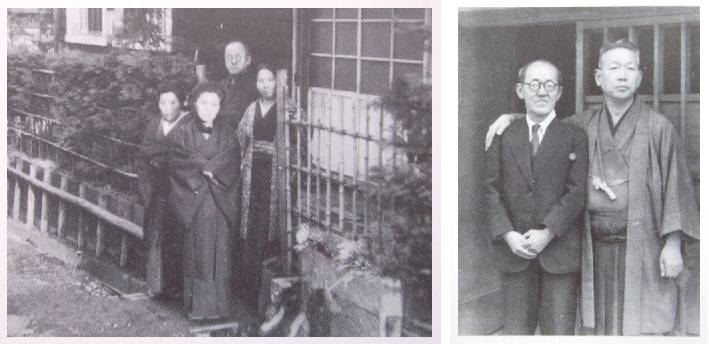 |
| Hasui and family (undated) and Hasui and fellow artist Ito Shinsui c. 1940 |
the sister of Kanagaku Robun, a well-known literary figure of Meiji Japan. The family frequented the theaters of Tokyo and Hasui later recalled the enormous impression made by the actors, the stories, and the staging.
As a child, Hasui was plagued by a series of illnesses which left him weakened and with poor eyesight. For his recuperative periods he went to live with his aunt, Kakimoto Natsu, in the mountains hot spring country of Shiobara, north of Tokyo. Shiobara became his second home and he delighted in its scenic views. His first prints were of Shiobara as were several of his later prints. He painted there during the war years.
As a young man he attended the school of the painter Aoyagi Bokusen where he compiled designs and sketched from nature. He studied brush painting with Araki Kanyu and copied the woodblock prints of the masters. His father required that he enter the family business, which he did reluctantly. Business was not his forte and the enterprise foundered. In 1908 it was turned over to his sister’s husband and Hasui, at age twenty-six, was able to devote himself to a career in art.
He subsequently studied under the Western-style artist Okada Saburosuke (1869-1939) of the Hakubakai or White Horse Society, and later under the Japanese-style artist Kaburagi Kiyokata. Hasui stated that his interest in landscape painting dated from his association with the Hakubakai. It was Kiyokata that gave him the name Hasui, which translates approximately to “water gushing from a spring,” but was derived more prosaically from the name of his elementary school coupled with one of the ideograms of his family name. Kawase itself means “river rapids.”
Association with Watanabe Shozaburo
Watanabe Shozaburo started his print shop in 1906 selling original ukiyo-e prints to Europeans and Americans. As those original prints became scarcer and more expensive, it became apparent that there was money to be made in making and selling quality reproductions from newly carved blocks of ukiyo-e prints. He hired the best printers and carvers and demanded excellence from his staff in the creation of those reproductions. In 1915, Watanabe seeing the potential of the export market for fine prints, decided to produce new prints (which he called shin hanga) of the highest quality for the export market. While he had the skilled craftsman to produce the new work, he lacked the artists devoted to new creations in the medium. Watanabe looked for brilliant young artists, perhaps just starting out in their careers, that he could mold and inspire to greatness. After attending an exhibition of Kaburagi Kiyokata and his students in 1915 he approached, with Kiyokata's approval, several of his students including Hasui. Hasui responded enthusiastically when Watanabe approached him. During a trip to Shiobara in 1918 Hasui made drawings of the local scenery and showed them to his teacher Kiyokata who exclaimed "Why, these are already prints!"
Late in the same year and in 1919 Watanabe published Hasui's four prints of Shiobara. They met with acclaim and Hasui was established as Watanabe's landscape artist. Although personally reticent, he immediately asserted himself artistically. Narazaki, Hasui's biographer, noted that the work of his first year was unlike anything produced by his teachers Kiyokata, Kanyu, or Okada Saburosuke (1869-1939) and questioned him on this point. Hasui’s prints were reminiscent of the paintings of Imamura Shiko who represented a style in vogue in the Taisho Period. Hasui replied to Narazaki that everybody, including Ito Shinsui and Iwata Sentaro, as well as a French artist (whose name he unfortunately forgot), was experimenting with these lines, forms and perspectives.
Late in the same year and in 1919 Watanabe published Hasui's four prints of Shiobara. They met with acclaim and Hasui was established as Watanabe's landscape artist. Although personally reticent, he immediately asserted himself artistically. Narazaki, Hasui's biographer, noted that the work of his first year was unlike anything produced by his teachers Kiyokata, Kanyu, or Okada Saburosuke (1869-1939) and questioned him on this point. Hasui’s prints were reminiscent of the paintings of Imamura Shiko who represented a style in vogue in the Taisho Period. Hasui replied to Narazaki that everybody, including Ito Shinsui and Iwata Sentaro, as well as a French artist (whose name he unfortunately forgot), was experimenting with these lines, forms and perspectives.
Creating Atmospheric Prints
Hasui produced exceptional prints depicting moonlight, rain, rising and setting sun, the waters of ocean and river, rocks, mist, and mountains. But of all his works, the best and the most original are the snow scenes.
In 1920, Hasui designed the first of his falling snow prints. These transcended anything achieved before in color woodblock printing. He later recalled “In my earlier works there are novel expressions in carving line and forms: the artisans used to complain.” Hasui was familiar enough with carving, however, to believe it was possible for carvers to prepare the required blocks. Some of his most charming snow prints are those that combine traditional Japanese convention with Western lighting and shading. They are true twentieth-century successors to the prints of Hiroshige.
Hasui’s night scenes and his blue and gray mood scenes constitute another group of his most outstanding prints. With these he was able, as he put it, to simplify and not falsify as the darkness fused the objects depicted.
Not infrequently artist and printer experimented with the same set of blocks to produce a series of prints. With major color changes it was possible to turn night into day.
In 1920, Hasui designed the first of his falling snow prints. These transcended anything achieved before in color woodblock printing. He later recalled “In my earlier works there are novel expressions in carving line and forms: the artisans used to complain.” Hasui was familiar enough with carving, however, to believe it was possible for carvers to prepare the required blocks. Some of his most charming snow prints are those that combine traditional Japanese convention with Western lighting and shading. They are true twentieth-century successors to the prints of Hiroshige.
Hasui’s night scenes and his blue and gray mood scenes constitute another group of his most outstanding prints. With these he was able, as he put it, to simplify and not falsify as the darkness fused the objects depicted.
Not infrequently artist and printer experimented with the same set of blocks to produce a series of prints. With major color changes it was possible to turn night into day.
Matsue, Izumo
Series: Souvenirs of travel, third series 1924
Kawase Hasui; The Complete Woodblock Prints, Kendall Brown; Amy Reigle Newland, Amsterdam, Hotei Publishing, KIT Publishers, 2003
Nos. 124, 124a, 124b
Series: Souvenirs of travel, third series 1924
Kawase Hasui; The Complete Woodblock Prints, Kendall Brown; Amy Reigle Newland, Amsterdam, Hotei Publishing, KIT Publishers, 2003
Nos. 124, 124a, 124b
The Lone Figure
There has been speculation as to the significance of the lone figures in Hasui’s prints. They appear to be reflecting, contemplating and, yes, worshiping as they are moved by the grandeur of the natural world. Others see deeper meaning. They have postulated that the figures, be they lay people or monks, are substitutes for Hasui himself, that they express the artist’s lonely existence. Hasui and his wife Mume were childless. He had few students and, perhaps most important, he regarded his work as the termination of a long tradition in Japanese-style landscape art.
Print Production
It is appropriate at this point in our discussion to consider the relationship of the artist with publisher, carver, and printer in shin hanga production. On this subject there has been a good deal of misinformation in Western writings. Worse, Western authors have been quoting other Western authors thus giving credence to error.
The following is Hasui’s own description of print production.
I draw the original thinking of the final product. There are occasions when the final prints do not measure up to the original expectations. There are also happy occasions when the prints turn out to be superior to original paintings because they are prints.
As true with any occupation, it requires training. One must try hard constantly. There can be no relaxation at any time. One must work diligently throughout life.
Woodblock prints in particular involve the work of more than one person. It is like gidayu – Japanese puppetry – with puppet handlers, singers and musicians.
There is no problem if the carver carves faithfully in accordance with the artist’s design. It is quite troublesome if the carver tries to express his own individuality. Carving faithfully requires experienced technical hands.
In the case of printing we must interact very closely. A less experienced printer might waste seven or eight trial prints before a successful one is made. If someone is experienced we can decide on the final print after two or three trials. It occurs occasionally that despite best efforts, a successful print is still not produced. This is the hard part of composite art. It requires telepathic communication. Unless all parties are completely in tune, the process will not work. When my mind and the minds of the artisans are in complete agreement, a good work can be generated.
It is the publisher, of course, who bears ultimate responsibility both for the selection of the design for printmaking from the artist's sketchbook and for the final publication. Watanabe has provided us with his thoughts as publisher: “As it is the main object of a colour-print to express its peculiar colour-feeling superior to an original painting or a draught, we take interest in it if it is nicely printed. And if it does not turn out satisfactorily, the renewed printing is often tried more than ten times at intervals, and the wood-blocks are improved or added to when necessary. Because the printing is supervised by the publisher, when he feels like it the publication is often delayed, sometimes taking three or four years after wood-blocks are made. So much as that, both the artist and the publisher take pains not to bring out trash-works into the world.” This description is accompanied by a picture of artist and printer at work. Watanabe entitled it “the artist Hasui is supervising the printing of a proof sheet by Ono Gintaro,” thus leaving no doubt as to the artist’s role even in the very last stages of the process.
Narazaki provides us with interesting insight into the artist as printmaker, stating that an artist seeking unrestricted expression of talent is unsuited for such a career. “The printmaker must constantly keep in mind that his paintings and sketches must ultimately be reduced to carvings in wood. Even the subject matter is affected. The woodblock artist must, of necessity, suppress and inhibit uncontrolled expression of feeling.” He quotes Hasui directly: “Some say my drawings look like woodblock prints. I sketched, however, scenes that can be expressed as prints. In earlier days I used to sketch wherever I pleased. In more recent years I started sketching scenes where it was unnecessary to move even a single blade of grass in designing my prints. I found that the very landscapes started looking like prints to me. I do not paint subjective impressions. My work is based on reality, I cannot falsify, even though I can simplify. I try to make the people in my pictures characteristic of local manners and customs. If I’m drawing a large temple gate, I’ll draw a distant view. Then I get closer and draw the structure of each part in careful detail. I make mental impressions of the light and color at the time of sketching. Later, back at my inn, I fill in the color. While coloring the sketch, I am already imagining the effects in a woodblock print.”
The following is Hasui’s own description of print production.
I draw the original thinking of the final product. There are occasions when the final prints do not measure up to the original expectations. There are also happy occasions when the prints turn out to be superior to original paintings because they are prints.
As true with any occupation, it requires training. One must try hard constantly. There can be no relaxation at any time. One must work diligently throughout life.
Woodblock prints in particular involve the work of more than one person. It is like gidayu – Japanese puppetry – with puppet handlers, singers and musicians.
There is no problem if the carver carves faithfully in accordance with the artist’s design. It is quite troublesome if the carver tries to express his own individuality. Carving faithfully requires experienced technical hands.
In the case of printing we must interact very closely. A less experienced printer might waste seven or eight trial prints before a successful one is made. If someone is experienced we can decide on the final print after two or three trials. It occurs occasionally that despite best efforts, a successful print is still not produced. This is the hard part of composite art. It requires telepathic communication. Unless all parties are completely in tune, the process will not work. When my mind and the minds of the artisans are in complete agreement, a good work can be generated.
It is the publisher, of course, who bears ultimate responsibility both for the selection of the design for printmaking from the artist's sketchbook and for the final publication. Watanabe has provided us with his thoughts as publisher: “As it is the main object of a colour-print to express its peculiar colour-feeling superior to an original painting or a draught, we take interest in it if it is nicely printed. And if it does not turn out satisfactorily, the renewed printing is often tried more than ten times at intervals, and the wood-blocks are improved or added to when necessary. Because the printing is supervised by the publisher, when he feels like it the publication is often delayed, sometimes taking three or four years after wood-blocks are made. So much as that, both the artist and the publisher take pains not to bring out trash-works into the world.” This description is accompanied by a picture of artist and printer at work. Watanabe entitled it “the artist Hasui is supervising the printing of a proof sheet by Ono Gintaro,” thus leaving no doubt as to the artist’s role even in the very last stages of the process.
Narazaki provides us with interesting insight into the artist as printmaker, stating that an artist seeking unrestricted expression of talent is unsuited for such a career. “The printmaker must constantly keep in mind that his paintings and sketches must ultimately be reduced to carvings in wood. Even the subject matter is affected. The woodblock artist must, of necessity, suppress and inhibit uncontrolled expression of feeling.” He quotes Hasui directly: “Some say my drawings look like woodblock prints. I sketched, however, scenes that can be expressed as prints. In earlier days I used to sketch wherever I pleased. In more recent years I started sketching scenes where it was unnecessary to move even a single blade of grass in designing my prints. I found that the very landscapes started looking like prints to me. I do not paint subjective impressions. My work is based on reality, I cannot falsify, even though I can simplify. I try to make the people in my pictures characteristic of local manners and customs. If I’m drawing a large temple gate, I’ll draw a distant view. Then I get closer and draw the structure of each part in careful detail. I make mental impressions of the light and color at the time of sketching. Later, back at my inn, I fill in the color. While coloring the sketch, I am already imagining the effects in a woodblock print.”
Making a Living as a Print Maker
Hasui was not an employee of the S. Watanabe Color Print Company. He was paid for the sketches Watanabe selected for transformation into prints and for work that was specifically commissioned. He sold his watercolors as a source of additional income. Japanese print artists, by tradition, have not been well-paid and Hasui was no exception. He designed over fifty prints for other publishers than Watanabe for reasons that were primarily economic.
The earthquake and fire of 1923 destroyed Hasui’s home and sketchbooks of his travels which were filled with ideas for future prints. Watanabe’s place of business was also destroyed along with all unsold prints and the blocks from which they were prepared. Anticipating the reconstruction of his establishment, Watanabe provided Hasui with funds to enable him to travel for one hundred days and prepare new sketches for prints. Upon his return, he and Ito Shinsui each derived some income by providing sketches to the Itsetatsu company which were published in 1925 and 1926.
A few years later Hasui had a new home constructed. Narazaki relates that there was a misunderstanding between Hasui and the builder, resulting in substantial cost overruns. To generate additional income he designed prints for the publishers Kawaguchi, Bijutsusha, Tokyo Shobido, Doi Sadaichi, and Kato between 1927 and 1932. Kawaguchi, in particular, produced some beautiful prints. In those trying years Hasui was forced to be very frugal. As an aside, Narazaki tells us that in the early 1930s people were whispering to one another that “Hasui is still wearing the kimono that Watanabe gave him.” Some believe that such statements were also meant to imply that Hasui’s work was being overly influenced by Watanabe’s preferences.
If we met the artist, we would have had no clue as to the intensity, zeal and sense of mission with which he approached his work. His biographers refer to him repeatedly as honest, faithful, punctual, conscientious, straight-forward, and kind. He had a sense of humor which he excluded from his work. He enjoyed word-play and puns, which come readily in Japanese because the ideograms have multiple meanings. His humor was frequently self-directed, as when he called himself “hanga-do” which translates to “print publisher” but the same symbols also mean “half play, half art” or “semi-serious artist.”
The earthquake and fire of 1923 destroyed Hasui’s home and sketchbooks of his travels which were filled with ideas for future prints. Watanabe’s place of business was also destroyed along with all unsold prints and the blocks from which they were prepared. Anticipating the reconstruction of his establishment, Watanabe provided Hasui with funds to enable him to travel for one hundred days and prepare new sketches for prints. Upon his return, he and Ito Shinsui each derived some income by providing sketches to the Itsetatsu company which were published in 1925 and 1926.
A few years later Hasui had a new home constructed. Narazaki relates that there was a misunderstanding between Hasui and the builder, resulting in substantial cost overruns. To generate additional income he designed prints for the publishers Kawaguchi, Bijutsusha, Tokyo Shobido, Doi Sadaichi, and Kato between 1927 and 1932. Kawaguchi, in particular, produced some beautiful prints. In those trying years Hasui was forced to be very frugal. As an aside, Narazaki tells us that in the early 1930s people were whispering to one another that “Hasui is still wearing the kimono that Watanabe gave him.” Some believe that such statements were also meant to imply that Hasui’s work was being overly influenced by Watanabe’s preferences.
If we met the artist, we would have had no clue as to the intensity, zeal and sense of mission with which he approached his work. His biographers refer to him repeatedly as honest, faithful, punctual, conscientious, straight-forward, and kind. He had a sense of humor which he excluded from his work. He enjoyed word-play and puns, which come readily in Japanese because the ideograms have multiple meanings. His humor was frequently self-directed, as when he called himself “hanga-do” which translates to “print publisher” but the same symbols also mean “half play, half art” or “semi-serious artist.”
Documenting Japan's Scenery
In his forty years as a print artist he traveled the length and breadth of Japan to record for posterity the wonders of its scenery. He portrayed its broad vistas and its single alleys, its castles and temples and also its farmers' huts. All types of weather conditions were depicted, all times of day and night and all its moods from deep gloom to cherry-blossom springtime. Many of his pictures are devoid of people and those with more than two are rare. When he does include human figures they are always common people engaged in dignified pursuits, whether they be farmers at work, monks on pilgrimage, father or mother with child, or just individuals coping with rain or snow or lost in thought as they contemplate the beauties of their surroundings. Hasui’s figures are almost always seen from behind. We become mesmerized by his mood pictures. Frontality would cause the viewer to become self-conscious and thus break the spell. The few exceptions are images of laboring people coming home at the end of the day, obviously so tired that they would take no notice of the viewer anyway.
He recorded Japan of the Taisho (1912-1926) and early Showa (1926-1957) Periods in the same way that Kobayashi Kiyochika (1847-1915) preserved a record for us of the Meiji days (1867-1912). Because of the nostalgic feelings they evoke in a nation fearing the loss of its traditional ways, these prints are being widely sought by the Japanese of today.
He recorded Japan of the Taisho (1912-1926) and early Showa (1926-1957) Periods in the same way that Kobayashi Kiyochika (1847-1915) preserved a record for us of the Meiji days (1867-1912). Because of the nostalgic feelings they evoke in a nation fearing the loss of its traditional ways, these prints are being widely sought by the Japanese of today.
Intangible Cultural Treasure
In 1953 the Japanese government’s Committee for the Preservation of Intangible Cultural Treasures wished to honor traditional printmaking and took steps to confer upon both Hasui and Shinsui the status of National Living Treasure, the former for his landscape artistry and the latter for his bijin-ga. However, objections were raised because their work involved the essential collaboration of artist, engraver, and printer, making it awkward to single out one participant in each collaboration for formal recognition. Instead the artists were commissioned to create new prints, the preparation of which was carefully documented. The resulting artworks and the records were then enshrined in places of honor and designated Intangible Cultural Treasures. Narazaki, Hasui’s biographer, served as recorder of the process of woodblock printmaking for this purpose.
Artist's Death
Hasui died November 27, 1957. In 1982 there was a retrospective exhibition of 180 of his approximately 620 major prints in Tokyo. The catalogue was entitled Kawase Hasui: The End of the Line For Ukiyo-e. If it was indeed the end, it was a conclusion in grand style.
Hasui Signatures and Seals
Source: Kawase Hasui; The Complete Woodblock Prints, Kendall Brown; Amy Reigle Newland, Amsterdam, Hotei Publishing, KIT Publishers, 2003, p. 157-158
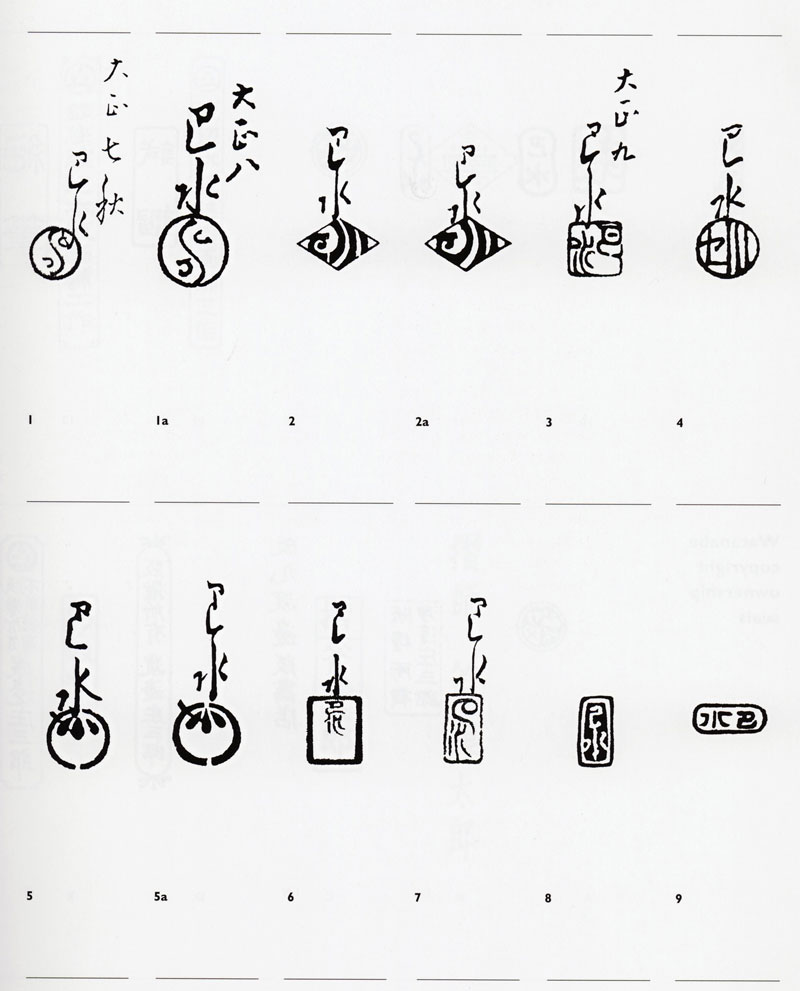
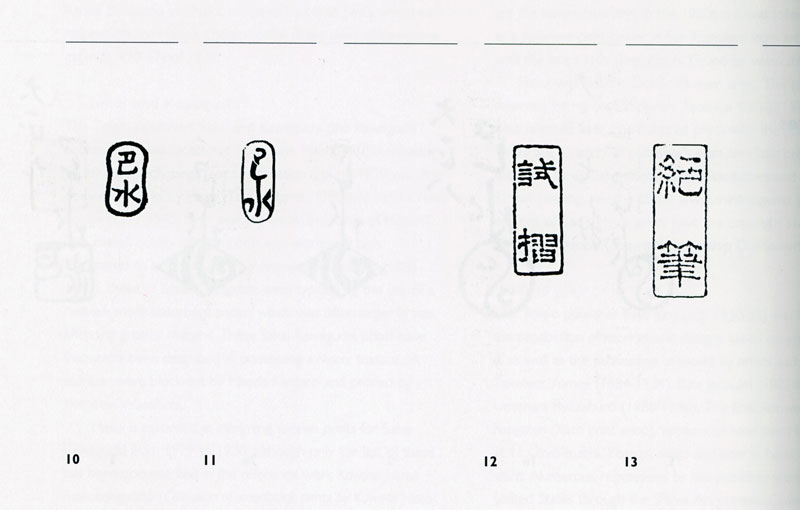


1. Date (here Taishō shichi aki [1918, autumn]), Hasui signature with Hasui seal
1a. Date (here Taishō hachi [1919]), Hasui signature with Hasui seal
2. Hasui signature with Kawase seal
3. Hasui signature with Kawase seal
3a. Date (here Taishō kyū [1919]), Hasui signature with Hasui seal
4. Hasui signature with Kawase seal
5. Hasui signature with Kawase seal
5a. Hasui signature with Kawase seal
6. Hasui signature with Kawase seal
7. Hasui signature with Kawase seal
8. Hasui seal
9. Hasui seal
10. Hasui seal
11. Hasui seal
12. Shizuri ('trial or proof printing') seal
13. Zeppitsu ('last or final brush [work] seal
Carnegie Museum of Art Exhibition "Kawase Hasui: Landscapes of Modern Japan" (November 13, 2004 - May 8, 2005)
The color woodblock print has a long and illustrious history in Japan, a history that culminated in the great landscape prints of artists such as Utagawa Hiroshige in the early nineteenth century. After the Imperial government opened Japanese ports to the Western world in 1868, the publication of color prints declined but was revitalized in the early years of the 20th century by artists inspired by a more modern Japan, but a Japan with deep roots in native tradition.Kawase Hasui (1883–1957), one of modern Japan's most important and prolific printmakers, drew his inspiration from his native landscape. Initially a painter and commercial illustrator, Hasui came to printmaking when he was nearly 40 years old, but with a talent uniquely suited to translating the landscape into print. Hasui was a traditionalist, modest and self-effacing, devoted to recording both the great monuments and the undiscovered pleasures of Tokyo, Kyoto, and the Japanese countryside.
Hasui's landscapes portray a Japan quickly disappearing. In the early 20th century, Japan was rapidly becoming westernized and modern. In the aftermath of the devastating earthquake of 1923, Tokyo burned to the ground; the city was rebuilt, only to be destroyed once more during the Allied firebombing of 1945. Hasui's home was destroyed both times, but nowhere are the effects of such cataclysmic events evident in his art. In his prints, tranquility and beauty reign, as though an idyllic Japan existed in his mind's eye, aJapan immune to change, immutable in its purity. Hasui designed approximately 600 prints over a career that spanned some 40 years. Near the end of his career in 1952, the Japanese government officially recognized Hasui for his contribution to Japanese culture.
The prints in this exhibition are drawn from the museum's James B. Austin Collection of Japanese prints and from a private Pittsburgh collection.
Minneapolis Institute of Arts Exhibition "Woodblock Prints by Kawase Hasui" (Saturday, March 7, 2009—Sunday, May 31, 2009)
Kawase Hasui (1883–1957) was one of the first artists associated with the shin-hanga (literally “new print”) movement that arose in the 1920s. Shin-hanga artists specialized in nostalgic, romanticized views of Japan, which were produced using the time-honored system of enlisting the aid of a publisher, woodblock carvers, and highly skilled printers. Thus, “new” referred to the revival of traditional woodblock print production. In contrast, artists associated with the sosaku-hanga (creative print) movement were inspired by the Western ideal of the independent artist who carved and printed his own designs. In the wake of the rapid modernization of Japan that began at the end of 19th century, Hasui’s traditional approach to print production—and his conventional subjects—were not immediately popular in Japan. Instead, the first and most ardent collectors of his work were Americans and Europeans who lamented the changes that were taking place in Japan and who longed for the charm and exoticism of the country when it was first “opened” to the West.
This exhibition features 13 prints by Hasui, showing how the artist’seyes captured the timeless beauty of Japanese scenery in the midst of amajor transformation that was taking place in the country.
Literature
Kawase Hasui and His Contemporaries: The Shin Hanga (New Print) Movement in Landscape Art,, Irwin J. Patcher, Everson Museum of Art, Syracuse, 1986.Visions of Japan: Kawase Hasui's Masterpieces, Kendall H. Brown, Hotei Publishing, 2004
Catalogue Raisonnés
Two catalogue raisonnés have been published as follows:Kawase Hasui; The Complete Woodblock Prints, Kendall Brown; Amy Reigle Newland, Amsterdam, Hotei Publishing, KIT Publishers, 2003
Kawase Hasui Mokuhangashu, Narazaki, Muneshige, ed., Kodansha & Mainichi Shimbun, Tokyo, 1979
